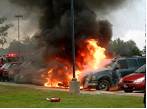Incident Report
Subject: Fires in Cars
Date
of Email reporting Incident: Mon 28/05/2007
Report Detail:

New Technologies, New Risks
A renewed interest in fires in cars is warranted in light of the changing technology of vehicles. The introduction of hybrid electric vehicles (HEVs), the increasing interest in full electric vehicles (EV) and fuel cell vehicles raises new fire hazards on our roads. The development of new fuels based on vegetable oils and ethanol and the increasing use of lightweight materials, all change the fire risks and fire behaviour of cars.
Causes
The most common single identifiable cause of car fires after arson is from electrical faults. In 2004 there were 13,400 accidental car fires, with 71% being caused by vehicle defects, where wiring and battery faults were the biggest single cause. Arson was the most common cause of car fires, accounting for a further 46,900 vehicles. The electrical faults are of concern. Future vehicles are
expected to have both higher voltages and larger electrical reserves than existing vehicles, more potential and more energy is available to initiate fires.
Fuels
While traditionally petrol and diesel have been the primary road fuels, efforts to pursue lower carbon dioxide emissions has resulted in the growth of alternative fuels and the use of batteries for motive power.
Vegetable oils provide little additional risk when compared to diesel fuels. The auto-ignition temperature and flammability limits for the two fuels are similar and the risks are reasonably understood. Ethanol by contrast, while performing in a similar manner to petrol has significantly wider flammability limits, and posses a greater ignition risk if spilt.
Gaseous fuels, such as natural gas (NG, primarily methane), Liquid Petroleum Gas (LPG) and hydrogen present an expanded range of fire and explosion risks when placed beside conventional fuels. While NG and LPG have flammability limits that are similar to petrol, their gaseous state at ambient temperatures mean that flammable vapour clouds can be generated by leaks. Hydrogen, lastly, has wide flammability limits (4%-74% by volume) and readily forms flammable vapour clouds, creating an dangerously explosive combination. This is especially true in confined spaces, such as garages and underground car parks.
Batteries
While not generally considered as fuel, batteries form the last in a line of fire hazards for vehicles. The most readily perceived is that from electrical shorts, which has been demonstrated by the statistics to date, however batteries, like fuel tanks, are a concentrated store of energy and may generate flammable gases and liquids. The most commonly used lead acid batteries generate small quantities of hydrogen when charged, and the development of large Nickel Metal Hydride batteries for HEV, may liberate large quantities of hydrogen when heated even to relatively low temperatures. It is expected that Lithium Ion batteries, such as those used in lap tops, will become more prevalent in HEVs and EVs over the next decade, and the higher energy density of these batteries coupled with an organic electrolyte posses another fire risk.
Fire Transfer
The ignition of one vehicle by a neighbouring vehicle on fire has been a reasonably rare occurrence. Vehicles have tended to have all metal exteriors which provide good short term resistance to ignition. However, with pursuit of lighter vehicles, external plastic panels, wheel arches and crash zones have become common. These areas are less resistant to ignition from high radiation loads, such as a nearby fire, and fire transfer from one vehicle to the next is more likely.
Future Changes
As the numbers of alternatively fuelled vehicles (EV, HEV, fuel cells and ethanol) on our roads rises, the fire risks need to be reconsidered. The EV, HEV and Fuel cells vehicle all have the capacity to vent large quantities of hydrogen when heated to as little as 100 degrees centigrade. While this is a high ambient temperature, it is a temperature that rapidly develops in a fire situation. With the increase of future vehicles on our roads, a single vehicle fire is likely to spread more easily and liberate more gaseous fuels than currently occurs. Fire transfer is likely to be more common and more rapid as a result.
For more information on this and other fire risks in the transport industry contact CWA International’s Fire and Explosion Group.
|

